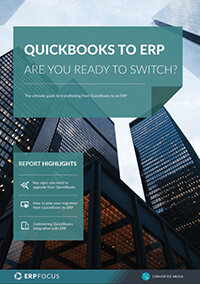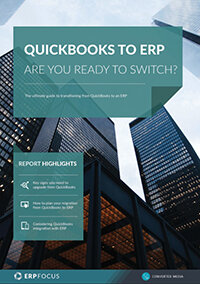Approaching Challenges Associated with a QuickBooks to ERP Migration
There are a host of practical challenges associated with the decision to migrate an on-going enterprise platform from QuickBooks to a more robust ERP solution. Perhaps the most daunting of these issues regards intrinsic scale-of-operations differences between what can fairly be referred to as a ‘small-business’ system in the form of QuickBooks, versus a more sophisticated entree enterprise platform like a Tier 1 or 2 ERP system.
While these dissimilarities may be based on decisions regarding size, function, and data elements, before one can get to the wheat as it were, one must first clear away the chaff. In the event of an ERP migration, this means working through the myriad of ‘wetware’ issues posed by a sudden, enterprise-sized lack of confidence driven by the decision to discard central financial/resources capabilities in favor of going headfirst down the rabbit hole by hurtling toward one or more big, and usually scary operational unknowns.
Once you have made the decision to switch from Quickbooks to ERP, here are several ways to move forward with a QuickBooks to ERP migration without frightening everyone in your company.
Know What You are Buying and Why
This primarily applies to senior management cadres that on the one hand, may enjoy the concept of real-time resource reporting when sitting at lunch, but don’t clearly understand how deep these systems subsume and control operations on a daily basis. The response here is simple. Learn about the value of a new system first, then follow-up by actively pushing any new value-knowledge all the way down to the enterprise floor.
For example, when comparing QuickBooks and SAP’s Business One system, there are a host of extended capabilities immediately available to any expanding enterprise including;
- Account Number Sophistication - No account segmentation in QuickBooks, versus up to 10 account segments in Business One
- Inventory - Basic inventory tracking in QuickBooks versus a constellation of capabilities such as average cost valuations, serial numbering, record batching, multi-warehouse management, FIFO record management, and average and standard costing.
- Scalability - QuickBooks exhibits retrograde speed as one’s enterprise data mass expands. On the other hand Business One offers a cloud based capability that scales-up on demand.
Identify and secure a solid implementation partner
Knowledge represents nothing unless action accompanies it. Therefore, when taking a hard look at an ERP implmentation, it’s paramount that any ‘incoming’ systems partner binds itself to the same culture as an enterprise itself. This means that if your company is somewhat lazy about migration scheduling, then a systems partner should offer the same level of response (why one would operate this way is beyond me, but it is what it is). On the other hand, however, if your company fosters and values hard-charging business response, then a systems partner should offer the same level of activity.
Sell On, Sign On – This element can not be over-sold, nor can it be a one-time event. If everyone is not on the same page, an enterprise software migration will fail. In this case, the right approach here is to sell, sell, sell; then encourage your enterprise workforce to ‘sign on’ to the change either formally or informally. This activity should drive from the top down, by executing active systems education sessions well ahead of the time a company’s systems partner appears at the door. This early buy-in process pays huge dividends down the road, and at the same time, will gain early favor from the workforce ranging from the executive to shop floors.
Respond then respond again – This bit of confidence-building goes to the heart of any migration-based enterprise evolution. Whether a company is expanding from spreadsheets to QuickBooks, or QuickBooks to ERP, the premise of emotional support driven by an immediate response to any query must be met quickly, directly and accurately. There is nothing more damaging to a migration evolution than to have a worker ask a question and get minimal or no support, particularly when management is trying to sell an enterprise systems change.
So, there you go. Granted these are just a few ways to approach the challenges associated with a QuickBooks to ERP migration, since each enterprise is different. Nevertheless, if you start working on ‘wetware’ challenges first, employee buy-in will be achieved much more easily executed going forward, thereby creating a more efficient overall end-to-end migration process.
Free white paper

Quickbooks to ERP: Are You Ready to Switch?
Get the definitive guide to converting your business from Quickbooks to ERP

Related articles
-

A beginner’s guide to ERP integration
What is ERP integration, why it matters, and more!
-

CMMC Compliance: What Aerospace and Defense Manufacturers Need to Know
Key insights on CMMC compliance, deadlines, and securing DoD contracts with CMMC 2.0 certificatio...
-

QuickBooks vs ERP: What ERP does better
Could your accounting & inventory management benefit from upgrading to ERP?

